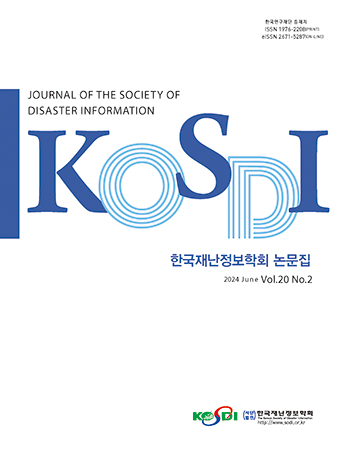Research Article
Abstract
References
Information
Purpose: In this study, the location and history information of the cavity identified in the cavity exploration, such as repacking of the pavement, is not known. Therefore, it is to review the field applicability of RFID(Radio Frequency Identification) systems that enable anyone to accurately identify information. Method: Basic experiments were conducted for field applicability for cavity recognition distance, recognition and recognition rate, tag performance and tag type, reader interference, communication, underground burial impact, and duplicate recognition by RFID system. Results: As a result of the depth of tag and reader recognition, the electronic tag chips and readers applied in the basic experiment are judged to be effectively applicable in the field environment where the road cavity is located. Conclusion: The RFID tags for field application of the pavement management system store various information such as location and size of cavity, identification date, cause of occurrence, and surrounding underground facilities to maximize cavity management effect with a system that can be computerized and mobile utilization.
연구목적: 본 연구는 도로함몰 예방을 위하여 공동탐사시 확인된 공동 중 포장층의 재포장 공사 등에 의한 공동관련 위치 및 이력 정보를 알 수 없게 되어 누구라도 정보를 정확하게 파악할 수 있도록 할 수 있는 RFID(Radio Frequency Identification) 시스템의 현장 적용성을 검토하는 것이다. 연구방법: RFID 시스템에 의한 공동 인식거리, 인식 여부와 인식율, 태그 성능과 태그 종류, 리더기 간섭, 통신, 지하 매설물 영향, 중복 인식 등에 대하여 현장 적용성을 위한 기초실험을 수행하였다. 연구결과: 태그와 리더기 인식 심도, 태그 정보 입력 및 리더기 인식 여부 결과, 기초 실험에 적용된 전자태그칩과 리더기는 도로 공동이 위치한 현장 환경에서 효과적으로 적용성이 있는 것으로 판단된다. 결론: 포장도로관리스템의 현장 적용을 위한 RFID 태그에 공동위치를 포함하여 공동에 관한 확인 일자, 공동의 규모, 발생원인, 주변 지하매설물 등의 여러 가지 제반 정보를 저장하여 전산화 및 모바일 활용도 가능한 시스템으로 공동관리 효과를 극대화 할 수 있다.
- Bae, Y.S., Shin, S.Y., Won, J.S., Lee, D.H. (2016). The Road Subsidence Conditions and Safety Improvement Plans in Seoul. The Seoul Institute, 2016-PR-09, Seoul.
- Joo, W.L., Kim, H.S., Jung, Y.A., Hong, Y.C. (2017). “Advanced Indoor Location Tracking Using RFID.” Journal of the Korea Academia-Industrial, Vol. 18, No. 1, pp. 425-430.10.5762/KAIS.2017.18.1.425
- Kim, G.B., Ryu, S.H., Choi, G.H. (2016). “A Commercial Passive Tag Read Range Test for Optimization of RFID Tag Packaging in a Precipitation Environment.” Journal of The Korean Society for Urban Railway, Vol. 4, No. 4, pp.689-695.
- Kwon, S.W. (2004). "Technological Trends of RFID Technology and Its Application to Construction Sites." Building Construction, Vol. 4, No. 5, pp. 50-56.10.5345/JKIC.2004.4.4.050
- Lee, S.M., Yoon H.M. (2017). “A Study for Improvement of Policy on Ground Subsidence Prevention in Urban Areas.” The Journal of Seoul Studies, Vol. 18, No. 1, pp. 27-42.
- Oh, S.W., Kim, S.J., Hwang, J.G., Bang, H.C. (2011). “Technology Trends on Logistics Information Synchronization Using RFID.” Electronics and Telecommunications Trends, Vol. 26, No. 6, pp. 86-96.
- Park, J.H. (2006). “RFID Technology Trends and Its Application.” Electronics and Telecommunications Trends, Vol. 21, No. 3, pp. 137-146.
- Park, J.J., Kim, K.S., Kang, H.H., Kim, J.H., Hong, G. (2018). “Evaluation of Physical Properties and Long-term Stability of Expansion Materials for Emergency Repair by Temperature.” Journal of the Korea Society of Disaster Information, Vol. 14, No. 1, pp. 80-89.
- Seoul Metropolitan City(2014). Special management Measures for Road Sink.
- Seoul Metropolitan City(2015). A Study on the Management Policy and Response Manual of Road Sink in Seoul.
- Seoul Metropolitan City(2018a), 2017 Roadside Cavity Exploration Service(Step 2).
- Seoul Metropolitan City(2018b), Maintenance Manual of Road Pavement in Seoul.
- Publisher :The Korean Society of Disaster Information
- Publisher(Ko) :한국재난정보학회
- Journal Title :Journal of the Society of Disaster Information
- Journal Title(Ko) :한국재난정보학회논문집
- Volume : 15
- No :3
- Pages :391-401
- DOI :https://doi.org/10.15683/kosdi.2019.09.30.391




 Journal of the Society of Disaster Information
Journal of the Society of Disaster Information







